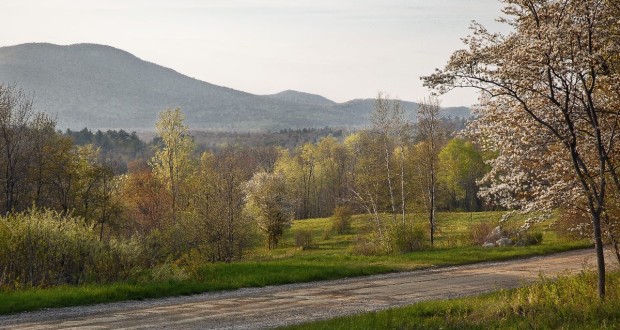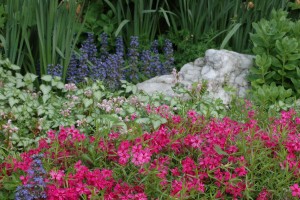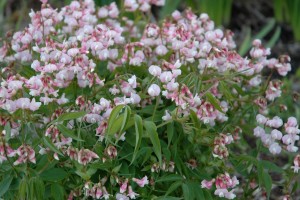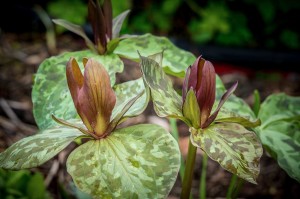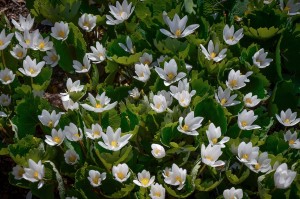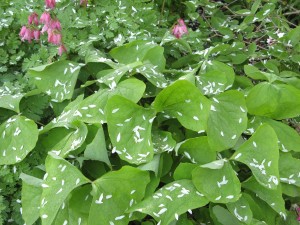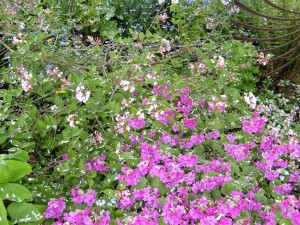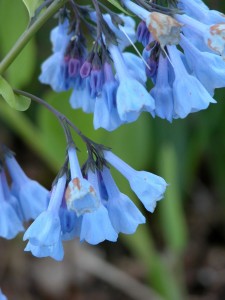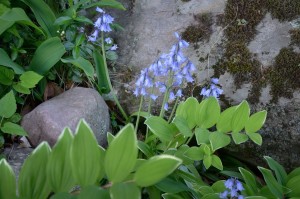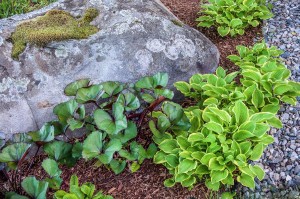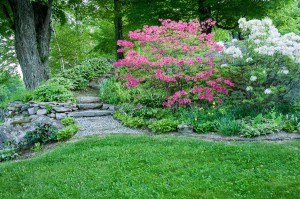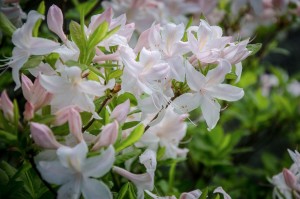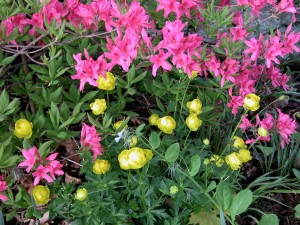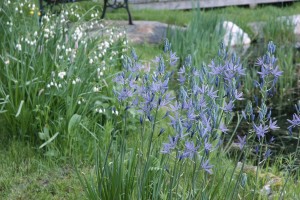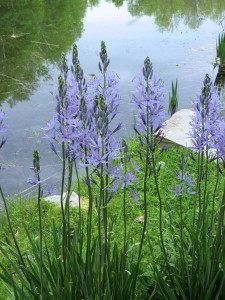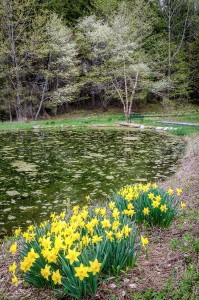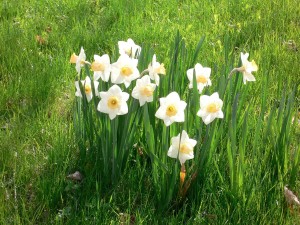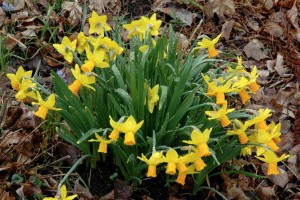Welcome Spring
This surely has been a long tedious winter which New Englanders everywhere are eager to put behind them. Indeed, for at least two months now, it seems we have all been concluding our emails with those plaintive entreaties to ‘think spring’!
But in April the magic of spring begins to unfold. A palpable sense of anticipation fills the air as we eagerly share our ‘signs of spring’ with everyone we meet. Just a few days ago our FedEx driver stopped to tell me he had just seen red-winged blackbirds in the valley.
And, as a gardener, I am eagerly watching as new growth gradually unfurls in the nearby woods and in my garden the treasured flowers of the season open their petals to receive the first pollinators.
Spring: fleeting magic
Spring comes gently to the mountains. April is often chilly and the woods still brown. But, before long, dainty ephemeral wildflowers–Spring Beauties, Dogs Tooth Violets, Bellwort, Trillium and Dutchman’s Breeches to mention some favorites– begin to carpet the forest floor and patches of Coltsfoot emerge from the grit beside the road.
In my garden a telltale row of yellow daffodils pops up in the warm soil along the south side of our house, proclaiming that winter has finally gone.
Now, as if to make up for lost time, by early May the new season progresses by leaps and bounds. It has an intensity and urgency that is totally unmatched at any other time of year; flowering trees and shrubs, perennials and bulbs, all burst forth in a rainbow of colors to celebrate the end of winter.
But spring is also fleeting, lasting a mere six weeks. By the first week of June it is time for the flowers of early summer—lilacs and peonies, roses and irises, catmint and salvia— to take center-stage in our gardens.
Spring in the garden
The first flowers of the season grow low to the ground. After all, in just a few short weeks they will complete their entire annual cycle of growth, flowering and setting seed.
So, to make a bold statement in the garden, I like to mass lots of them–same kinds or different kinds–together.
Fortuitously the bright clear colors of our favorite spring flowers all mix easily together—blues that match the hue of the mid-day sky shine against brilliant pinks, light purples and lots of yellow, and of course the yellow-green of new leaves.
To illustrate some of the many ways of combining the bountiful flowers of spring, I would like to share with you four different corners of my own garden and the spring flowers that thrive there. All are easily grown and all would make lovely additions to any North Country garden.
On the barn slope
The whole of this steep western-facing slope, capped by a handsome 75-year old farm barn, is easily visible from the house. The space is bisected by the path up to my vegetable garden, and a rustic boulder wall runs along the base. In springtime this is a sunny space, but by the end of May the nearby ash trees will cast their shadows during the middle of the day.
As soon as the snow pulls back in the middle of April, I will be anxiously waiting for the first snowdrops to emerge across the upper parts of the slope, telling me that spring is finally starting in the mountains. Next come the daffodils and Spring Vetch, an easily grown member of the sweet pea family that grows just a foot or so high.
By May, large patches of moss phlox (Phlox subulata) trail over the wall, providing welcome splashes of color. I am particularly fond of a bluish purple phlox (which has been in my garden for eons) growing beside a clump of bright yellow Aurinia ‘Basket go Gold’; for several weeks they make a wonderful picture together.
I also use the space behind the wall to experiment with new plants—or at least plants that are new to me. Now some sizable clumps of creamy double Hellebores, as well as several kinds of trillium, grow in this easily accessible soil. This spring I will also be carefully watching to see if a small patch of Bunchberries (Cornus canadensis) I planted a few years back will finally bloom for me.
Under the serviceberries
By the end of April the native serviceberries (Amelanchier arborea) in the woods around here will burst into flower. For me this amazing sight is like ‘SNOW IN THE SPRINGTIME’.
But, not to be outdone, at the entrance to our back garden I planted four smaller Shadblow Serviceberries (A. canadensis) that each spring create a dainty white canopy over the bed below.
Most of the bed is lightly shaded which has proven to be the perfect environment for some of our beloved native woodland wildflowers, including Bloodroot (Sanguinaria canadensis) with clear white flowers, purple woodland phlox (Phlox divaricata), the delicate Twinleaf (Jeffersonia diphylla), some fringed bleeding heart (Dicentra eximia) and plenty of Foamflower (Tiarella cordifolia).
Near the front of the bed, you can’t miss a Koreanspice bush (Viburnum carlesii) which fills the air with its heady fragrance. This small bush is surrounded by a carpet of bright pink Japanese Primroses (Primula kisoana). I do note however, that, while I love the brilliant color of these particular primroses in my spring garden, they need to be enclosed with a six-inch root barrier to prevent them from over-running other less exuberant neighbors.
And towards the back of the bed, which is more heavily shaded, the arrow-shaped leaves of Barrenwor (Epimedium versicolor ‘sulpureum’ and Epimedium x rubrum) create a pleasant groundcover all season long.
In the shade of old maples
Our small front garden is dominated by three ancient maple trees and a massive grey rock, no doubt a relic of the ice age. This wonderful craggy rock surface also creates a stunning backdrop for a small flower bed that I enjoy from my study window. And, despite the inevitable encroaching roots of those old maples, this bed is filled with spring flowers, as well as Variegated Solomon’s Seal, Hostas and Ligularia dentata that gradually fill out as summer progresses.
Throughout May the low growing perennials in this bed create a delightful study in blue and yellow. There are lots of yellow English primroses (Primula vulgaris) interspersed with our native Virginia bluebells (Mertensia virginica), as well as some blue lungwort (Pulmonaria) among the yellow globeflowers (Trollius chinensis).
Finally as spring is running its course, in the third week of May two large azalea bushes, Rhododendron ‘White Lights’ and R. ‘Bright Lights’, come into flower and steal the scene. And, since they are also easily visible from our quiet road, sometimes people driving along will pull over to inquire what they are.
In the wild
About ten years ago I planted some ‘naturalizing bulbs’ including Cama, Summer Snowflake and English Bluebells, in the meadow that we mow each the fall, also with delightful results each spring.
Also, over the years I planted lots of carefree daffodils in my flowerbeds. However all daffodil bulbs will multiply in place and eventually start to take over valuable bed space. So each June I make a habit of digging up clumps that have outgrown their welcome and relocating them either to the meadow or along the edge of the woods. This chore is best done as soon the flowers have died back, but before the leaves turn brown and disappear.
They have continued to expand in these wilder areas of the garden and now, each spring, they emerge out of the cold ground to create a ‘HOST OF GOLDEN DAFFODILS’, as immortalized two centuries ago by William Wordsworth.
